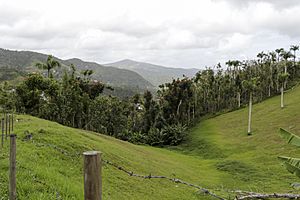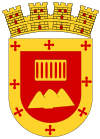San Lorenzo, Puerto Rico facts for kids
Quick facts for kids
San Lorenzo
Municipio Autónomo de San Lorenzo
|
|||
|---|---|---|---|
|
Town and Municipality
|
|||

Hills and valley in San Lorenzo
|
|||
|
|||
| Nicknames:
"Pueblo de Los Samaritanos", ("Town of Samaritans"), "La Tierra de Leyendas", ("Land of Legends")
|
|||
| Anthem: "Son tus campos de bellísimo verdor" | |||

Map of Puerto Rico highlighting San Lorenzo Municipality
|
|||
| Sovereign state | |||
| Commonwealth | |||
| Settled | 1811 | ||
| Founded | September 18, 1894 | ||
| Founded by | Valeriano Muñoz de Oneca | ||
| Named for | Saint Lawrence | ||
| Barrios | |||
| Area | |||
| • Total | 53.3 sq mi (138.07 km2) | ||
| • Land | 53.3 sq mi (138 km2) | ||
| • Water | 0.0 sq mi (0.07 km2) 0%% | ||
| Population
(2020)
|
|||
| • Total | 37,693 | ||
| • Rank | 27th in Puerto Rico | ||
| • Density | 707.2/sq mi (272.999/km2) | ||
| Demonym(s) | Sanlorenceños | ||
| Time zone | UTC−4 (AST) | ||
| ZIP Code |
00754
|
||
| Area code(s) | 787/939 | ||
| Major routes | |||
San Lorenzo is a town and municipality in Puerto Rico. It is located in the eastern central part of the island. San Lorenzo is north of Patillas and Yabucoa. It is south of Gurabo. To its east are Juncos and Las Piedras. To its west are Caguas and Cayey.
The town is known by two special nicknames: "The Town of the Samaritans" and "Land of Legends." The patron saint of San Lorenzo is Nuestra Señora de las Mercedes, which means Our Lady of Mercedes. Farmers in the area grow tobacco and sugar cane. San Lorenzo is part of the larger San Juan-Caguas-Guaynabo Metropolitan Statistical Area.
Contents
History of San Lorenzo
San Lorenzo was first settled in 1737. The local church was built in 1811. The town's original name was San Miguel de Hato Grande. It was later changed to San Lorenzo. This change happened because of a local story. It is said that Saint Lawrence appeared to people in the river valley.
Why San Lorenzo is Called "The Town of the Samaritans"
San Lorenzo got its nickname, "The Town of the Samaritans," from a special story. Around 1920, in the Hato area of San Lorenzo, many people visited a young girl named Julia Vazquez Torres. She was only 12 years old. People believed she had a special gift for healing.
Julia helped people using natural remedies. These included medicinal plants, minerals, and pure water from a nearby well. As she grew up, she continued to be known for her kindness and dedication to helping others.
Geography and Natural Features
San Lorenzo is in the eastern central part of Puerto Rico. It is surrounded by other municipalities. These include Patillas, Yabucoa, Gurabo, Caguas, Cayey, Juncos, and Las Piedras.
Mountains and Rivers
The Cayey Mountain Range runs through the area. San Lorenzo is also home to several important rivers:
- Río Cayaguás
- Río Emajagua
- Río Grande de Loíza
- Río de Las Vegas
Areas of San Lorenzo
San Lorenzo is divided into twelve main areas, called barrios. The main downtown area is called San Lorenzo Pueblo. Here are some of the barrios and their populations:
- Pueblo - 2,490 people
- Cayaguas - 1,345 people
- Cerro Gordo - 4,400 people
- Espino - 3,345 people
- Florida - 5,791 people
- Hato - 7,109 people
- Jagual - 4,316 people
- Quebrada - 2,231 people
- Quebrada Arenas - 2,751 people
- Quebrada Honda - 2,309 people
- Quemados - 4,771 people
Population Changes Over Time
| Historical population | |||
|---|---|---|---|
| Census | Pop. | %± | |
| 1900 | 13,433 | — | |
| 1910 | 14,278 | 6.3% | |
| 1920 | 18,136 | 27.0% | |
| 1930 | 23,479 | 29.5% | |
| 1940 | 26,627 | 13.4% | |
| 1950 | 29,248 | 9.8% | |
| 1960 | 27,950 | −4.4% | |
| 1970 | 27,755 | −0.7% | |
| 1980 | 32,428 | 16.8% | |
| 1990 | 35,163 | 8.4% | |
| 2000 | 40,997 | 16.6% | |
| 2010 | 41,058 | 0.1% | |
| 2020 | 37,693 | −8.2% | |
| U.S. Decennial Census 1899 (shown as 1900) 1910-1930 1930-1950 1960-2000 2010 2020 |
|||
The population of San Lorenzo has changed a lot over the years. In 1900, there were about 13,433 people. The population grew steadily for many decades. By 2010, it reached its highest point with 41,058 residents. In 2020, the population was 37,693.
Things to See and Do
San Lorenzo has several interesting places to visit. These landmarks show the town's history and culture.
Important Landmarks
- Priscilla Flores Theater: A place for performances and events.
- Santuario de la Virgen del Carmen in Montaña Santa: A special religious site.
- Gallera San Carlos: A place for traditional rooster fights.
- Residencia Machín–Ramos: A historic home.
- Río Grande de Loíza: One of Puerto Rico's longest rivers, starting in San Lorenzo.
- Iglesia Nuestra Señora de las Mercedes: A historic church built in 1737 and updated in 1993. It is located in the main town square.
- Hacienda Muñoz: A beautiful estate.
Economy and Local Industries
The economy of San Lorenzo has changed over time. It started with farming animals. Later, growing sugar cane became very important.
Farming and Agriculture
Sugar cane was a major crop, processed using old methods. Today, farmers also grow coffee and various fruits. The timber industry, which used to be big, has become smaller. This is because many forests were cut down without being replanted.
Local Industries
San Lorenzo also has different types of factories. These factories make many products. They produce clothing, medicines, and shoes. They also create electromechanical equipment and different kinds of paints.
Culture and Celebrations
San Lorenzo is a town rich in culture. It celebrates many festivals and events throughout the year.
Festivals and Events
The main celebration is the Fiestas Patronales Nuestra Senora de las Mercedes. This festival honors the town's patron saint in September. It is a mix of religious and cultural activities. You can enjoy parades, games, and local crafts. There are also fun rides, traditional food, and live music.
Other popular events include:
- Three Kings Caroling - January
- Cavalcade Moncho Roldán - January
- Candelaria Celebrations - February
- Kite Festival - March
- Cross Celebrations - May
- Embroidering and Weave Festival - September
- Passion Fruit Festival - November
Sports in San Lorenzo
Sports are an important part of life in San Lorenzo.
- The town has a Double-A (baseball) baseball team called Los Samaritanos. They have won national championships many times. They were champions in 1975, 1997, 1999, 2000, 2001, and 2002.
- The Agustin Reyes Half Marathon is a popular running event.
Transportation and Bridges
San Lorenzo has a network of roads and bridges. There are 49 bridges located within the municipality. These bridges help people travel and connect different parts of the town.
Symbols of San Lorenzo
Like many towns, San Lorenzo has its own official symbols. These include a flag and a coat of arms.
The Flag of San Lorenzo
The flag of San Lorenzo is divided into four equal rectangles. Two of these rectangles are yellow. The other two rectangles have red and yellow stripes.
The Coat of Arms
The coat of arms of San Lorenzo tells a story about the town.
- The grill is a key symbol. It represents Saint Lawrence, the town's patron saint. He was martyred by being burned on a grill.
- The hill or mountain on the coat of arms stands for Gregorio Hill. This hill is a major feature in the landscape of San Lorenzo.
- The cross is a symbol of Saint Michael the Archangel.
Famous People from San Lorenzo
Many talented people have come from San Lorenzo.
- Chayanne - A famous singer and actor.
- Ernestina Reyes “La Calandria” - A well-known singer.
- José Tous Soto - A former Speaker of the House of Representatives.
- Antonio Fernós-Isern - A former Resident Commissioner.
- José Aponte Hernandéz - Another former Speaker of the House of Representatives.
- Carmita Jiménez - A popular singer.
- Priscila Flores - A singer.
- El Invader #1 - A famous Puerto Rican wrestler.
- Dr. Marc H. Rosa - A former teacher, school administrator, and university professor.
- Josúe "Jay" Fonseca - A political commentator.
- Edwin Cruz - The lead singer of "Mechi."
- Antulio Parrilla Bonilla - A Jesuit priest known as the "Father of the Puerto Rican Cooperative Movement."
- Victor Rivera - A wrestler.
Images for kids
See also
 In Spanish: San Lorenzo (Puerto Rico) para niños
In Spanish: San Lorenzo (Puerto Rico) para niños









